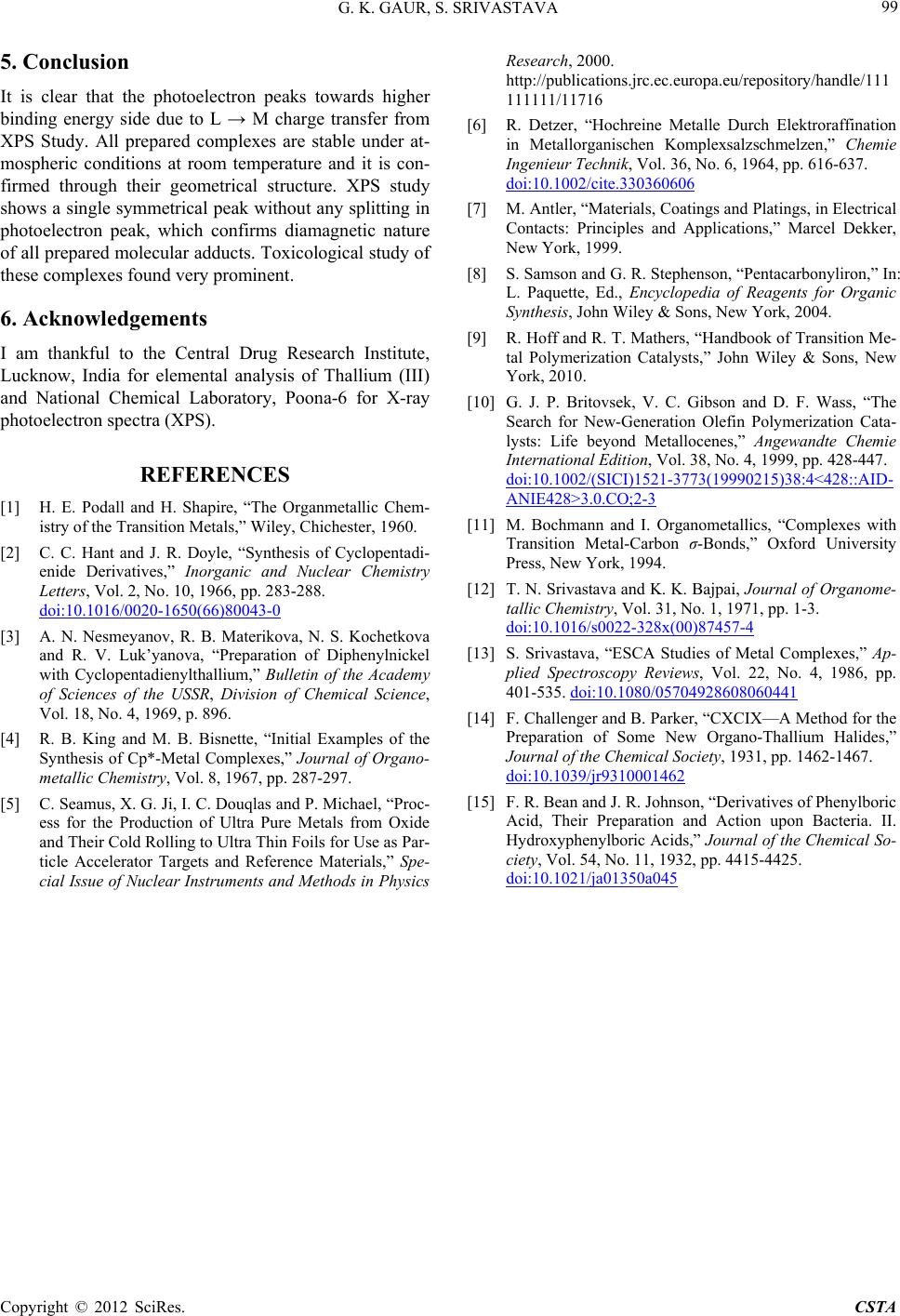
G. K. GAUR, S. SRIVASTAVA
Copyright © 2012 SciRes. CSTA
99
5. Conclusion
It is clear that the photoelectron peaks towards higher
binding energy side due to L → M charge transfer from
XPS Study. All prepared complexes are stable under at-
mospheric conditions at room temperature and it is con-
firmed through their geometrical structure. XPS study
shows a single symmetrical peak without any splitting in
photoelectron peak, which confirms diamagnetic nature
of all prepared molecular adducts. Toxicological study of
these complexes found very prominent.
6. Acknowledgements
I am thankful to the Central Drug Research Institute,
Lucknow, India for elemental analysis of Thallium (III)
and National Chemical Laboratory, Poona-6 for X-ray
photoelectron spectra (XPS).
REFERENCES
[1] H. E. Podall and H. Shapire, “The Organmetallic Chem-
istry of the Transition Metals,” Wiley, Chichester, 1960.
[2] C. C. Hant and J. R. Doyle, “Synthesis of Cyclopentadi-
enide Derivatives,” Inorganic and Nuclear Chemistry
Letters, Vol. 2, No. 10, 1966, pp. 283-288.
doi:10.1016/0020-1650(66)80043-0
[3] A. N. Nesmeyanov, R. B. Materikova, N. S. Kochetkova
and R. V. Luk’yanova, “Preparation of Diphenylnickel
with Cyclopentadienylthallium,” Bulletin of the Academy
of Sciences of the USSR, Division of Chemical Science,
Vol. 18, No. 4, 1969, p. 896.
[4] R. B. King and M. B. Bisnette, “Initial Examples of the
Synthesis of Cp*-Metal Complexes,” Journal of Organo-
metallic Chemistry, Vol. 8, 1967, pp. 287-297.
[5] C. Seamus, X. G. Ji, I. C. Douqlas and P. Michael, “Proc-
ess for the Production of Ultra Pure Metals from Oxide
and Their Cold Rolling to Ultra Thin Foils for Use as Par-
ticle Accelerator Targets and Reference Materials,” Spe-
cial Issue of Nuclear Instruments and Methods in Physics
Research, 2000.
http://publications.jrc.ec.europa.eu/repository/handle/111
111111/11716
[6] R. Detzer, “Hochreine Metalle Durch Elektroraffination
in Metallorganischen Komplexsalzschmelzen,” Chemie
Ingenieur Technik, Vol. 36, No. 6, 1964, pp. 616-637.
doi:10.1002/cite.330360606
[7] M. Antler, “Materials, Coatings and Platings, in Electrical
Contacts: Principles and Applications,” Marcel Dekker,
New York, 1999.
[8] S. Samson and G. R. Stephenson, “Pentacarbonyliron,” In:
L. Paquette, Ed., Encyclopedia of Reagents for Organic
Synthesis, John Wiley & Sons, New York, 2004.
[9] R. Hoff and R. T. Mathers, “Handbook of Transition Me-
tal Polymerization Catalysts,” John Wiley & Sons, New
York, 2010.
[10] G. J. P. Britovsek, V. C. Gibson and D. F. Wass, “The
Search for New-Generation Olefin Polymerization Cata-
lysts: Life beyond Metallocenes,” Angewandte Chemie
International Edition, Vol. 38, No. 4, 1999, pp. 428-447.
doi:10.1002/(SICI)1521-3773(19990215)38:4<428::AID-
ANIE428>3.0.CO;2-3
[11] M. Bochmann and I. Organometallics, “Complexes with
Transition Metal-Carbon σ-Bonds,” Oxford University
Press, New York, 1994.
[12] T. N. Srivastava and K. K. Bajpai, Journal of Organome-
tallic Chemistry, Vol. 31, No. 1, 1971, pp. 1-3.
doi:10.1016/s0022-328x(00)87457-4
[13] S. Srivastava, “ESCA Studies of Metal Complexes,” Ap-
plied Spectroscopy Reviews, Vol. 22, No. 4, 1986, pp.
401-535. doi:10.1080/05704928608060441
[14] F. Challenger and B. Parker, “CXCIX—A Method for the
Preparation of Some New Organo-Thallium Halides,”
Journal of the Chemical Society, 1931, pp. 1462-1467.
doi:10.1039/jr9310001462
[15] F. R. Bean and J. R. Johnson, “Derivatives of Phenylboric
Acid, Their Preparation and Action upon Bacteria. II.
Hydroxyphenylboric Acids,” Journal of the Chemical So-
ciety, Vol. 54, No. 11, 1932, pp. 4415-4425.
doi:10.1021/ja01350a045